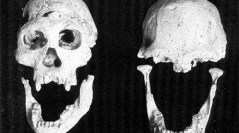

 Comptes Rendus Palevol
5 (1-2) - Pages 273-281
Comptes Rendus Palevol
5 (1-2) - Pages 273-281Excavations carried out since 1991 at the open-air site of Dmanissi, Georgia, have yielded four craniums, three mandibles, about 15 postcranial remains and a dozen isolated teeth. These remains correspond to at least four individuals, two adults and two adolescents. They were excavated from a precise stratigraphic, palaeontological and archaeological context above a basalt flow dated by K/Ar between 1.8 and 1.9 ± 0.01 Ma in a volcanic ash layer dated by 40Ar/39 Ar to 1.80 ± 0.05 Ma. The interest of these discoveries is fourfold: – (1) the dates obtained by diverse radiochronometric methods and by palaeomagnetism demonstrate, for the first time, that Man was present at the gates of Europe, in Transcaucasia at a much earlier period than that established by the classical scenario; – (2) faunal and pollens analyses have revealed that the environment was close to a savannah type, but much richer in water resources than the African environment. It was a temperate climate, with a mosaic of different landscapes due to the geomorphological diversity of the region, made up of valleys, lakes and the nearby mountains of the Great and Small Caucasus; – (3) the settlement of this human group could have been a direct consequence of a more humid environment, which followed a generalised aridification of the East of Georgia at the end of the Pliocene and which attracted fauna from both the East of the Eurasian continent and the North of the African continent; – (4) the morphofunctional aspects of these humans are close to those of Homo habilis and to those of the most archaic Homo erectus , which were the only species known in Africa up until now. Ascribed to a new species, Homo georgicus, small in size measuring 1.5 m with a cranial capacity of 600 to 700 cm 3 (half of modern man's capacity), they represent the ancestors of a long European or Eurasian lineage. Two new concepts can be retained: – the exodus from Africa took place earlier than previously thought, dating back to at least 1.8 Myr ago. It was carried out by Homo georgicus, a group close to Homo habilis; – it is no longer valid to base explanations of Man's migratory capacity in terms of cranial development. Homo georgicus , with a small brain volume, already had the faculty to adapt to a more favourable environment for his survival.
Homo georgicus , Dmanissi, Transcaucasia, Preoldowayan, Lower Pleistocene, cranial development